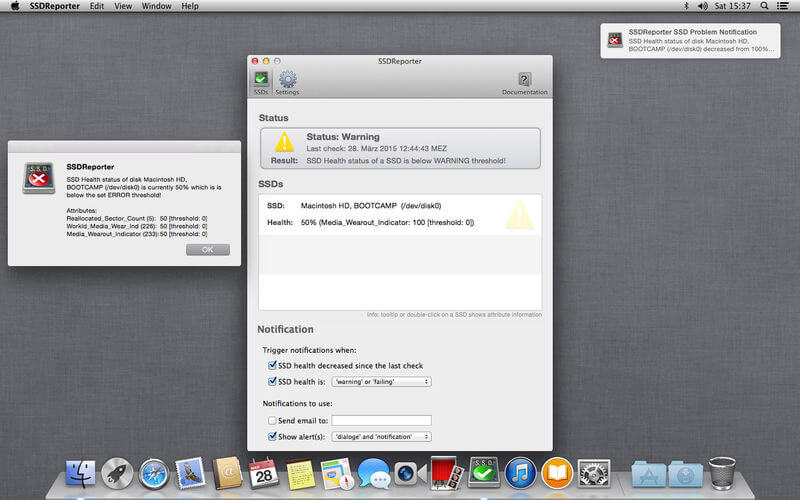

- #Smartreporter mac 2. mac os#
- #Smartreporter mac 2. serial#
- #Smartreporter mac 2. software#
- #Smartreporter mac 2. free#
That took 4 hours, so I let it run overnight. (I am still disappointed that Apple never supported FireWire on the old consumer MacBooks, but that’s another story.) I then restored my Snow Leopard backup from August 8 – the day before the Mini stopped booting from it – to the DeskStar drive, which is connected using FireWire, which is faster than USB 2.0. It’s not as fast as the 7200 RPM 320 GB drive, but it works. I used Time Machine to restore OS X 10.5 Leopard to the drive, and it works perfectly. On Saturday, I took apart the Mac mini, removed the troublesome 320 GB drive, and reinstalled the 80 GB drive that came with it. If anyone knows of a way to make a recovery disk or recovery partition, please share it so I can pass along that information to others still using Leopard and Snow Leopard. Booting from the optical drive is slow, but it works. You have to boot your Mac from an OS X 10.5 or 10.6 installation DVD, so I hope you have it and can find it – or have a source for a new disc. That didn’t come to Macs until OS X 10.7 Lion in 2011. Worse yet, if you’re using OS X Leopard or Snow Leopard, there’s no recovery partition. It wipes the drive and starts from scratch. It doesn’t care if there’s already a bootable version of OS X or even an earlier cloned version of the hard drive. It erases the destination drive and restores everything from your backup.
#Smartreporter mac 2. mac os#
I quit using it when I switched from Mac OS 9 to OS X. It was smart enough to only the copy files it needed to.
#Smartreporter mac 2. serial#
With Retrospect, you had to have a bootable system on your hard drive, the Retrospect control panel installed with a valid serial number, and start the restoration process, which might involve several tape swaps. Until this weekend, I had never had a reason to use Time Machine, and I assumed it would work like Retrospect, which I used in my IT days and also used on the Low End Mac network a decade or so back, in both cases backing up to tape. I have a 3 TB external Seagate USB 2.0 drive connected to my Mac mini, and it’s been partitioned so I can have bootable clones of the Mini’s Leopard and Snow Leopard partitions, as well as a partition for Time Machine backups. The destination drive should be at least twice a big as the drives it’s backing up, because it backs up and stores older copies of files so you can recover a previous version of a document, image, etc. Time Machine can back up to a local volume or over a network.
#Smartreporter mac 2. software#
Using Time MachineĪpple did everyone a solid when it included backup software with OS X 10.5 Leopard in late 2007. Still, I was able to boot the Mini from the cloned partition and then clone that to the DeskStar, which worked perfectly. Everything has been so reliable for so long that I got lazy about doing month updates. Problem is, my last backup is months old. It can create a bootable clone of your hard drive, and it was the first utility to do this as well as incremental updates, so your mirror of your work drive would be as current as your last backup. I have been backing up my Macs with SuperDuper! since 2004, and I love this app. That should be big just big enough to restore my backup, let me pare some obsolete files, and be ready to clone everything to SSD when I can afford it.ĭonations toward the cost of the SSD gladly accepted – click on the Donate button on the right.

But until I have funds for that, I dug out an old NewerTech miniStack enclosure with a 250 GB DeskStar hard drive. I plan to replace the hard drive with a 240-256 GB SSD, most likely a Samsung 850 EVO, which currently sells for $99.95 at .
I’d also need a way to recover whatever was on my work drive, as the Mac mini has been my primary production machine for some years now.
#Smartreporter mac 2. free#
I also received an error message from the free SMARTReporter 2.7 utility that the drive was having a problem, although the issue was not SMART-related. It would display a blue screen and continually try to complete the startup process, but to no avail. More precisely, it would no longer boot from the OS X 10.6 Snow Leopard partition on its internal 320 GB Seagate hard drive, which I’ve used for years. Since returning from vacation earlier this month, my 2007 Mac mini began to have problems and then died.


 0 kommentar(er)
0 kommentar(er)
